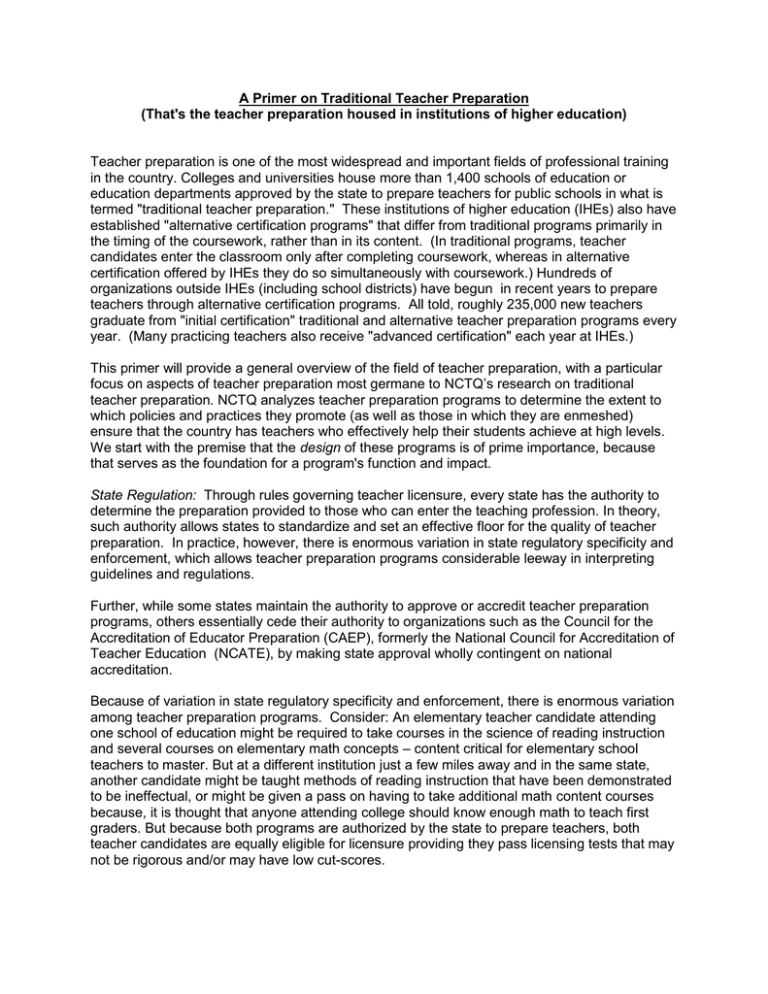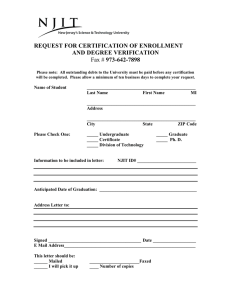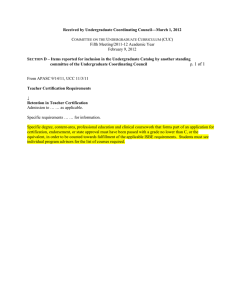A Primer on Traditional Teacher Preparation
advertisement

A Primer on Traditional Teacher Preparation (That's the teacher preparation housed in institutions of higher education) Teacher preparation is one of the most widespread and important fields of professional training in the country. Colleges and universities house more than 1,400 schools of education or education departments approved by the state to prepare teachers for public schools in what is termed "traditional teacher preparation." These institutions of higher education (IHEs) also have established "alternative certification programs" that differ from traditional programs primarily in the timing of the coursework, rather than in its content. (In traditional programs, teacher candidates enter the classroom only after completing coursework, whereas in alternative certification offered by IHEs they do so simultaneously with coursework.) Hundreds of organizations outside IHEs (including school districts) have begun in recent years to prepare teachers through alternative certification programs. All told, roughly 235,000 new teachers graduate from "initial certification" traditional and alternative teacher preparation programs every year. (Many practicing teachers also receive "advanced certification" each year at IHEs.) This primer will provide a general overview of the field of teacher preparation, with a particular focus on aspects of teacher preparation most germane to NCTQ’s research on traditional teacher preparation. NCTQ analyzes teacher preparation programs to determine the extent to which policies and practices they promote (as well as those in which they are enmeshed) ensure that the country has teachers who effectively help their students achieve at high levels. We start with the premise that the design of these programs is of prime importance, because that serves as the foundation for a program's function and impact. State Regulation: Through rules governing teacher licensure, every state has the authority to determine the preparation provided to those who can enter the teaching profession. In theory, such authority allows states to standardize and set an effective floor for the quality of teacher preparation. In practice, however, there is enormous variation in state regulatory specificity and enforcement, which allows teacher preparation programs considerable leeway in interpreting guidelines and regulations. Further, while some states maintain the authority to approve or accredit teacher preparation programs, others essentially cede their authority to organizations such as the Council for the Accreditation of Educator Preparation (CAEP), formerly the National Council for Accreditation of Teacher Education (NCATE), by making state approval wholly contingent on national accreditation. Because of variation in state regulatory specificity and enforcement, there is enormous variation among teacher preparation programs. Consider: An elementary teacher candidate attending one school of education might be required to take courses in the science of reading instruction and several courses on elementary math concepts – content critical for elementary school teachers to master. But at a different institution just a few miles away and in the same state, another candidate might be taught methods of reading instruction that have been demonstrated to be ineffectual, or might be given a pass on having to take additional math content courses because, it is thought that anyone attending college should know enough math to teach first graders. But because both programs are authorized by the state to prepare teachers, both teacher candidates are equally eligible for licensure providing they pass licensing tests that may not be rigorous and/or may have low cut-scores. Education schools/departments: Prospective teachers formally enter teacher preparation in an education school or department either in the middle of their undergraduate career (usually meeting some number of admission standards) or as graduate students.1 They either: 1) obtain an undergraduate and/or graduate degree in education, or 2) follow a specific program of study that does not lead to a degree in education but does meet state standards for teacher preparation. In most other fields, a graduate program is designed to build on undergraduate preparation, but with the exception of graduate programs for candidates in secondary education (who usually must major in the subject they plan to teach), graduate preparation in teaching often has little or no connection to the undergraduate background of the teacher candidate. Faculty: A tension exists in education schools and departments between the need to have faculty with the same sort of professional credentials as other higher education faculty (e.g., doctorates, published research) and the need to have faculty with practical experience teaching in K-12 classrooms. To a large extent this tension can be alleviated if practitioner faculty is dedicated to clinical courses in which teacher candidates spend a considerable amount of time doing field work in classrooms, with professional courses taught by faculty with customary academic credentials. Certification programs: 2 Education schools and departments offer programs structured to fit the nature of certification within a state. For example, Florida has middle school certification for grades 5-9, and therefore a Florida university might offer “English Language Arts 5-9” or “Social Studies 5-9” as programs in its education school. Another Florida university might not offer the Social Studies 5-9 program but might offer the English 5-9 program, perhaps with an English as a Second Language (ESL) “endorsement” that essentially offers a supplemental level of certification. (A neighboring state might not offer middle school certification at all and therefore would have no equivalent certification program at any of the colleges or universities in the state.) Even within one IHE, there may be variations in requirements for programs that one would assume would be identical. For example an English 5-9/ESL program offered at both the undergraduate and graduate level at the same IHE might require different coursework despite the fact that both are designed for initial certification of teacher candidates who have the same levels of relevant education. Components of Preparation Programs: There are three components to teacher preparation. The first pertains to content knowledge and involves coursework that the teacher candidate takes in order to teach English or math or geography with accuracy and authority. The second component is professional preparation, which entails coursework in child development, assessment, classroom management and methods or pedagogy. The third component is field experience, which might begin with a few hours of classroom observation and culminate in 1015 weeks of “student teaching” in which a teacher candidate serves as a classroom teacher for at least a few weeks. Requirements for a major: The course requirements for an academic (non-education) major largely determine the balance of content versus professional preparation in undergraduate teacher preparation, the route through which most teachers come to the profession. In fact, this 1 There are also post-baccalaureate teacher preparation programs that essentially offer certification (but not a graduate degree) after the college graduates that enter the programs complete one year of professional coursework. In California, virtually all traditional teacher prep programs are postbaccalaureate programs. 2 A major point of confusion arises from the use of the word “program” to refer both to the administrative units within education schools that prepare teachers and to certification pathways within such units. is so important an issue that 11 states require that all teacher candidates take a non-education major. Several other states require an “interdisciplinary major” as a means to have teacher candidates avoid an education major and its attendant lack of requirements for content preparation, but it is not clear that the results are as intended. In general, elementary and special education teacher candidates are required to have noneducation majors (or minors) less often than middle school or secondary teacher candidates. Most graduate programs assume that teacher candidates already know the subjects they will be teaching and therefore only require professional preparation. Consequently, except in the case of secondary teacher candidates, the programs don’t pay attention to the majors of incoming graduate students or to content coursework the students took in their undergraduate careers. The balance struck by teacher preparation programs between content and professional preparation can vary greatly. For example, if state law does not dictate that all teacher candidates have a non-education major, it is possible that an English 5-9 program at one education school will require that the teacher candidate have an English major and then take professional courses as essentially a second major or minor. But at another education school in the same state, the only English courses required might be those that the candidate takes to satisfy the university’s general education requirements as well as another course taught in the English department just for teacher candidates.


